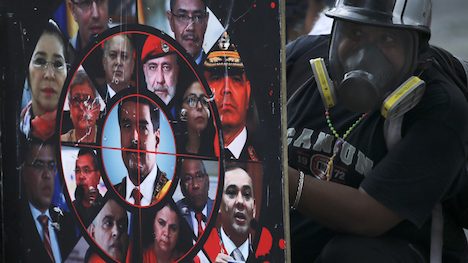The plan for U.S. military intervention in Venezuela is no longer a neoconservative fantasy, but a carefully crafted contingency plan going through the stages that often precede U.S. “humanitarian” interventions.
Since it was first introduced in June of this year, much has been written about the National Defense Authorization Act (NDAA), the bill that directs how the U.S. Department of Defense can and cannot use its funds over the course of fiscal year 2018. However, much of the coverage regarding the NDAA has been focused on a number of amendments that have been added to the bill by various members of the House and Senate — including amendments, which later failed, on ending the military’s use of indefinite detention without trial and the Authorization for Use of Military Force (AUMF), long criticized as a “blank check” used to by the government to continuously wage war without congressional input. The back-and-forth over amendments added to the bill by Congress has led to significant delays in the bill’s passage — which, however, remains highly likely according to political analysts. Yet, one focus of the NDAA, so far overlooked and likely to remain in the final version of the text, pertains to Venezuela, a nation that has found itself in Washington’s crosshairs for its socialist government and defiant stance against U.S. South American policy. In a report prepared justifying the NDAA’s approval and presented by the House Armed Services Committee, an entire section is devoted to “Venezuela Security and Stability,” a reference to the concerns regarding the country’s economic crisis – worsened by low oil prices and U.S. sanctions – as well as the political tensions between the ruling United Socialist party (PSUV) and the U.S.- funded opposition. The report states: The committee is concerned about U.S. Government contingency planning if a collapse of the Venezuelan Government and economy occurs. Therefore, the committee directs the Secretary of Defense, in coordination with other Federal Government agencies and departments that the Secretary deems appropriate, to provide a briefing, which may be classified, to the House Committee on Armed Services not later than September 30, 2017, on U.S. Government contingency plans for a potential humanitarian and migration crisis in Venezuela if its Government and economy collapse, to include the Department of Defense’s roles and responsibilities and assets [emphasis added] that would contribute to such plans.”
Threat of U.S. military intervention not a mere Trumpian blurt With the roadmap for the U.S. military’s “plans” for Venezuela if the country’s economic and political crisis worsens now established – yet not available to the public – it seems that President Donald Trump’s August warning that the U.S. would consider military intervention to “resolve” Venezuela’s crisis was hardly an impulsive statement. The current text of the NDAA also further highlights Congress’ push to have the Department of Defense consider Venezuela from a military perspective, linking the nation to the new “axis of evil” embraced by war hawks in Washington. In Title XII, Subtitle C – “Matters Relating to Syria, Iraq and Iran” — the bill casts Venezuela as a country cooperating militarily with Iran, Syria and North Korea, among other nations, although no factual evidence is offered for such claims. Sec. 1234 includes the following: (7) An assessment of military-to-military cooperation between Iran and foreign countries, including Cuba, North Korea, Pakistan, Sudan, Syria, Venezuela, and any other country designated by the Secretary of Defense with additional reference to cooperation and collaboration on the development of nuclear, biological, chemical, and advanced conventional weapons, weapon systems, and delivery vehicles.”Stated differently, the NDAA requests that the Department of Defense evaluate Venezuela from a military perspective while considering it part of the bloc challenging U.S. global hegemony, which also includes Russia and China – named as “potential adversaries” in the bill’s text. Taken along with Trump’s prior comments, increased U.S. sanctions against Venezuela over the past year, and the nature of the media coverage of the U.S. role in covering the country’s crisis, there is every reason to conclude that the U.S. government is once again considering an intervention in Venezuela. The pattern is now a familiar one. Having been unable to bring about collapse through economic sabotage or the millions of dollars spent funding opposition leaders and protests, recent U.S. government measures taken in regard to Venezuela, including the NDAA, are notably similar to measures that preceded U.S. interventions in Iraq and Libya. The plan for U.S. military intervention in Venezuela is no longer a neoconservative fantasy, but a carefully crafted contingency plan going through the stages that often precede U.S. “humanitarian” interventions. Source URL |

